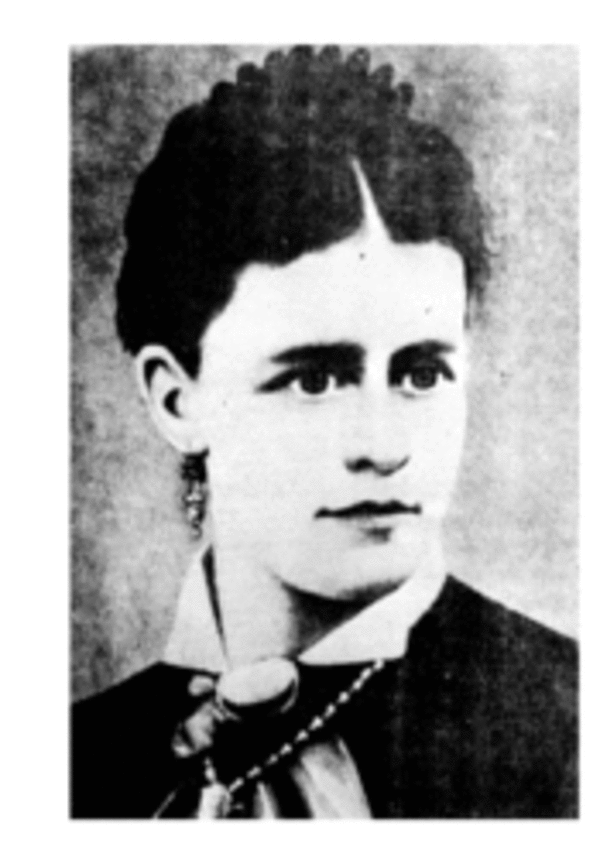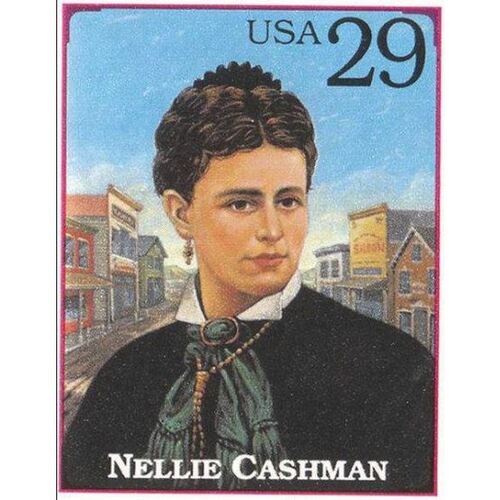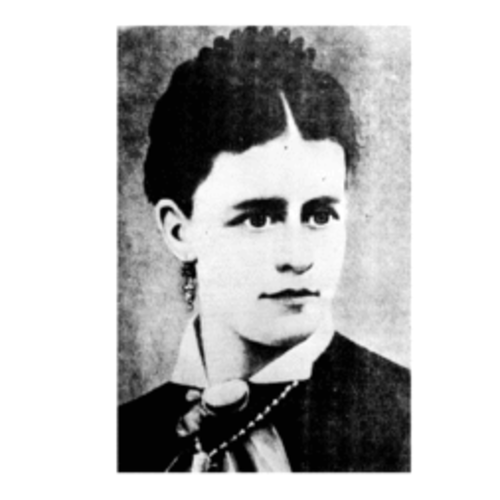
Source: Courtesy of Wikimedia Commons
CASHMAN, ELLEN (also known as Nellie Pioche and Irish Nellie), miner, prospector, philanthropist, and businesswoman; b. c. 1845 near Queenstown (Cobh, Republic of Ireland), daughter of Fanny Cashman; d. unmarried 4 Jan. 1925 in Victoria.
With thousands of other desperate Irish Catholic immigrants, Nellie Cashman came to Boston with her mother and sister about 1860. They then moved west, making their home in San Francisco in 1869. It was there that Nellie and her mother contracted mining fever and they soon left for the silver camps of Nevada, stopping in Virginia City, the Comstock, and Pioche. In 1872 the Cashmans opened the Miner’s Boarding House in Pioche, a venture that marked the beginning of Nellie’s lifelong pattern of operating a small business to support her mining ventures. After only a year in Pioche, Nellie, with an otherwise all-male party of 200 Nevada prospectors, headed for the remote Cassiar gold-mining district of northern British Columbia. There, she later told reporters, she “alternately mined and kept a boarding house for miners,” which she ran through the summer of 1873. In the fall she relocated in Victoria, where she intended to winter in the milder climate of the coast.
While Cashman was sitting out the winter, news of a shortage of supplies and an outbreak of scurvy at a camp in the Cassiar incited her to action. After persuading six men to accompany her, she set out on a relief run against all odds. For 77 days they trudged through deep snow, surviving avalanches, extreme temperatures, and all manner of storms. Upon her arrival, Cashman nursed the scurvy victims and distributed food and supplies. She spent two years in the Cassiar, during which time she helped the Sisters of St Ann raise funds to build St Joseph’s Hospital in Victoria [see Salomée Valois*]. Her heroic winter journey and her philanthropic commitment earned her the nicknames Miner’s Angel and Angel of the Cassiar. Moreover, her colourful personality and quick wit established her as a favourite with journalists, who would follow her activities for many years. (Much of the information about her is difficult to verify because various newspapers reported wildly different stories.)
Cashman left the Cassiar in 1876 and toured the mining camps of the American west before arriving in 1879 in Tucson, in the Arizona Territory, to prospect and establish the Delmonico Restaurant. Tucson’s boom was waning, however, and within a few months she pushed on to the new silver camp of Tombstone. Here Irish Nellie funded her mining ventures with a series of businesses that included a boot and shoe store, a grocery, a restaurant, a boarding house, and a hotel.
As she had done in British Columbia, she balanced her businesses and prospecting with charitable work. She raised money to establish St Mary’s Hospital in Tucson in 1880 and a Roman Catholic church, a hospital, and the first public school in Tombstone between 1880 and 1885. In Tombstone she was also an active member of the Irish National Land League, which supported the needy families of Irish miners. After the death in 1884 of her sister, Frances, she acted briefly as foster mother to her five nieces and nephews. Her reputation for warm-heartedness would follow her for the rest of her life. Unlucky miners could almost always find a room and a meal at her establishments even if they could not pay, and miners without money for a new prospect could often negotiate a grubstake with her. She might have lived out her life in ease, but Tombstone’s boom went bust in 1886 and her businesses collapsed. The following year she headed out for new eldorados, a prospecting tour that included New Mexico, Idaho, Wyoming, Mexico, South Africa, and new camps in Arizona.
In 1897, at her hotel in Yuma (Ariz.), Cashman heard of the great gold discoveries in Canada’s Yukon territory [see Shaaw Tláa*]. She could not resist the call of the Klondike. As she told the Arizona Daily Citizen (Tucson) in September, she intended to leave as soon as she could organize a party of prospectors and raise $5,000. By February 1898 she and two male companions were in Victoria assembling supplies and planning their route northward. When asked by the Victoria Daily Colonist what a lady prospector might wear for such a journey, she shocked the journalist by replying, “I dress . . . in many respects as a man does, with long heavy trousers and rubber boots. Of course, when associating with strangers, I wear a long rubber coat. Skirts are out of the question up north as many women will find out before they reach the gold fields.” Interestingly, all of the surviving pictures of Cashman show her wearing respectable full-length skirts and shirtwaists, characteristic of female attire of the period.
Cashman was among the 30,000 or more stampeders who descended on Dawson in the early summer of 1898. Like many others, she had arrived too late to stake a claim on the richest ground, though the one she purchased on Bonanza Creek yielded over $100,000. But wealth was fleeting for Nellie Cashman: “I spent every red cent of it buying other claims and prospecting the country. I went out with my dog team or on snow shoes all over that district looking for rich claims.” As a female miner, Cashman was exceptional – in 1901 only one per cent of the miners in the Yukon were women. The largest group of mining women appear to have established claims only to increase family holdings. To support her mining habit during her residence in Dawson, Cashman operated a restaurant and later a grocery store in the Donovan Hotel, one of two run by female proprietors in Dawson in 1901 (the other 27 shops were owned by men, often as family enterprises).
From Dawson, Cashman followed the lure of gold to Alaska, first to Fairbanks in 1905 and then in 1907 to the Koyukuk region, where she mined and prospected into her late seventies. In the spring of 1924 she contracted double pneumonia and was hospitalized in Fairbanks; determined to come “home to die,” she moved to St Joseph’s Hospital in Victoria in October. She passed away there in January 1925 and was buried in Ross Bay Cemetery.
Arizona Hist. Soc., Southern Arizona Div. (Tucson), Photographs of Ellen Cashman, including negative no.1847. NA, RG 31, C1, 1901, Dawson City, Yukon. Sisters of St Ann Arch. (Victoria), Photograph of Ellen Cashman. Arizona Daily Citizen (Tucson), 15 Sept. 1897. Daily Arizona Citizen (Tucson), 29 July 1879. Daily Colonist (Victoria), 15 Feb. 1898, 11 Jan. 1925. Ely Record (Pioche, Nev.), 4 Sept. 1872. Don Chaput, Nellie Cashman and the North American mining frontier (Tucson, Ariz., 1995). Directory, San Francisco, 1869. Suzann Ledbetter, Nellie Cashman: prospector and trailblazer (El Paso, Tex., 1993). M. J. Mayer, Klondike women: true tales of the 1897–98 gold rush ([Athens, Ohio], 1989). C. [L.] Porsild, Gamblers and dreamers: women, men, and community in the Klondike (Vancouver, 1998). Sally Zanjani, A mine of her own: women prospectors in the American west, 1850–1950 (Lincoln, Nebr., 1997).
Cite This Article
Charlene Porsild, “CASHMAN, ELLEN (Nellie Pioche, Irish Nellie),” in Dictionary of Canadian Biography, vol. 15, University of Toronto/Université Laval, 2003–, accessed January 19, 2026, https://www.biographi.ca/en/bio/cashman_ellen_15E.html.
The citation above shows the format for footnotes and endnotes according to the Chicago manual of style (16th edition). Information to be used in other citation formats:
| Permalink: | https://www.biographi.ca/en/bio/cashman_ellen_15E.html |
| Author of Article: | Charlene Porsild |
| Title of Article: | CASHMAN, ELLEN (Nellie Pioche, Irish Nellie) |
| Publication Name: | Dictionary of Canadian Biography, vol. 15 |
| Publisher: | University of Toronto/Université Laval |
| Year of publication: | 2005 |
| Year of revision: | 2005 |
| Access Date: | January 19, 2026 |




